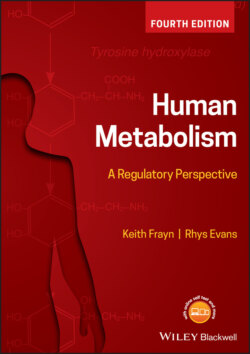Читать книгу Human Metabolism - Keith N. Frayn - Страница 40
1.3.2.1.7 Pentose phosphate pathway
ОглавлениеOne further pathway of glucose metabolism will be mentioned briefly: the pentose phosphate pathway. Again, this pathway occurs in the cytosol. This involves the metabolism of glucose 6-phosphate through a complex series of reactions that generate pentose sugars, used in nucleic acid synthesis, and also reducing power in the form of NADPH (Figure 1.14).
The pathway comprises two parts: an oxidative (irreversible) stage, initiated by the enzyme glucose-6-phosphate dehydrogenase, which generates NADPH and the pentose (5-carbon) sugar ribulose 5-phosphate, and then a non-oxidative (reversible) stage which interconverts the pentose sugar into a wide variety of 3 carbon (triose), 4 carbon (tetrose), 5 carbon (pentose), 6 carbon (hexose), and 7 carbon (heptose) sugars. These sugars are used for the synthesis of nucleotides and aromatic amino acids, whilst NADPH provides energy for many reductive biosyntheses – including lipogenesis and amination of 2-oxoacids to amino acids (glutamate dehydrogenase – see below); hence this is a pathway active in anabolic states. NADPH also maintains the antioxidant glutathione in its reduced (active) form (GSH). Because the relative requirements for the two products of the pentose phosphate pathway (pentose sugars and NADPH) varies, when NADPH demand exceeds pentose need, the sugar can be reinserted into glycolysis (hence ‘pentose phosphate shunt’).
